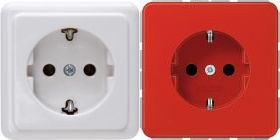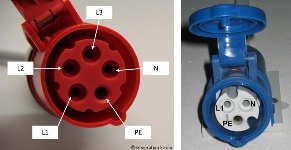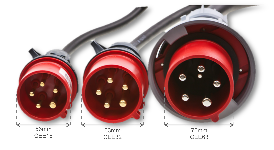An Bord FS Heincke werden verschiedene elektrische Spannungen bereitgestellt.
- 380V/50Hz /3phasig ohne Null
- 220V/50Hz/1phasig mit Null
- 24V DC für besondere Verbraucher
- USV-Labornetz für unterbrechungsfreie Stromversorgung der Labore
- 220V/ 20kVA / 20min mit 2x20kVA Parallelredundanter USV für Laborsteckdosen
- Landanschlu0 380V 3phasig mit Null max. 250A
Die Laborversorgung ist im normalen Seebetrieb durch die Labor-USV-Anlage vom Fahrnetz entkoppelt.
Die Nautischen Verbraucher werden durch den rotierenden Umformer versorgt.
Große wissenschaftliche Verbraucher können jederzeit wahlweise auf den Umformer geschaltet werden oder direkt über das 380V 3ph. Netz versorgt werden.
220 Volt, 50 Hz
Der übliche "Hausstrom" wird in allen Bereichen an Bord zur Versorgung gestellt. Es gibt ein normales Netz und ein abgesichertes Netz, in dem eine Unabhängige Stromversorgung (USV) zwischen geschaltet ist, die eine Glättung des Stroms gegen Überspannungen bewirkt. Das abgesicherte Netz ist also für empfindliche Abnehmer wie eleketronische Geräte (Laptops, Messgeräte, ...) vorgesehen. Das agbesicherte Netz ist an den Steckdosen mit rotem Gehäuse ersichtlich. Die Steckdosen sind vom Typ CEE 7/3, die benötigten Stecker ("Schuko-Stecker", international Typ "F") vom Typ CEE 7/4 oder CEE 7/7.
Im Hangar ist auch drei Steckdosen vom Typ CEE installiert, die der Sicherheitsnorm IP44 genügen und der Norm IEC 60309 / DIN EN 60309 für 220V entsprechen. Für die blaue Steckdose wird ein Stecker mit 3 Pins benötigt: L+N+PE,6h.
Die 220V-Steckdosen sind mit 16 Ampere abgesichert.
380 Volt, 50 Hz
Für Abnehmer größerer Stromstärken steht das 380V Netz zur Verfügung. Die Buchsen sind vom Typ IEC 60309 / DIN EN 60309 für die Aufnahme von Steckern mit 5 Pins: 3L+N+PE,6h. Im Hangar sind zwei Buchsen mit der Absicherung von 16 Ampere sowie eine mit 32 Ampere verfügbar.
Im Container-Anschlussraum neben dem Hangar sind zwei weitere Buchsen mit Absicherung von 16 Ampere, eine für 32 Ampere und eine für 63 Ampere vorhanden.
Die benötigten Stecker unterscheiden sich in ihrer Größe abhängig von der Ampere-Zahl (siehe Graphik).
CEE 7/3 Buchsen ("Schuko") für 220V: Ein weißes Gehäuse zeigt das normale Netz an, ein rotes Gehäuse das abgesicherte Netz.
CEE Buchsen für 380V (links) and 220V (rechts)
CEE Stecker für verschiedene Ampere-Absicherungen
Various electrical voltages are provided on board FS Heincke.
380V/50Hz /3phase without zero
220V/50Hz/1phase with zero
24V DC for special consumers
UPS laboratory network for uninterruptible power supply of the laboratories
220V/ 20kVA / 20min with 2x20kVA parallel redundant UPS for laboratory sockets
Shore connection 380V 3-phase with zero max. 250A
The laboratory supply is decoupled from the mains supply during normal sea operation by the laboratory UPS system.
The nautical consumers are supplied by the rotating converter.
Large scientific consumers can be optionally switched to the converter at any time or supplied directly via the 380V 3ph. mains.
220 Volt, 50 Hz
The usual "house current" is provided for supply in all areas on board. There is a normal mains and a fused mains, in which an independent power supply (UPS) is interposed to smooth the current against overvoltages. The fused network is therefore intended for sensitive consumers such as electronic devices (laptops, measuring instruments, etc.). The fused network can be identified by the sockets with red housings. The sockets are of type CEE 7/3, the required plugs ("Schuko plugs", international type "F") are of type CEE 7/4 or CEE 7/7.
Three CEE type sockets are also installed in the hangar, which meet the IP44 safety standard and comply with the IEC 60309 / DIN EN 60309 standard for 220V. A plug with 3 pins is required for the blue socket: L+N+PE,6h.
The 220V sockets are fused with 16 amps.
380 Volt, 50 Hz
For consumers of higher currents, the 380V mains is available. The sockets are of type IEC 60309 / DIN EN 60309 to accept plugs with 5 pins: 3L+N+PE,6h. In the hangar, two sockets with a fuse rating of 16 amps and one with a rating of 32 amps are available.
In the container connection room next to the hangar there are two more sockets with fuse protection of 16 amps, one for 32 amps and one for 63 amps.
The required plugs differ in size depending on the number of amps (see diagram).


